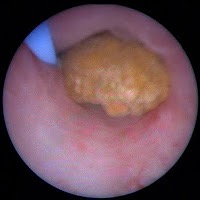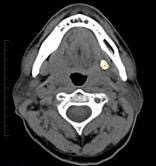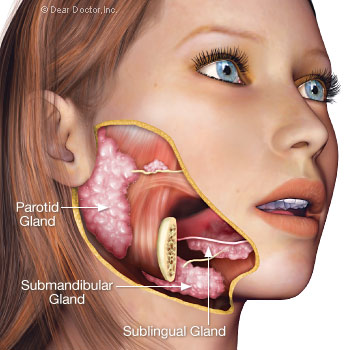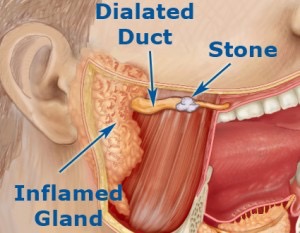Sialendoscopy in Austin
Dr. Nason's Blog
I am happy to be the first physician in Austin to provide a new and very effective technique to treat salivary gland obstruction.
This technique, called sialendoscopy, employs very small endoscopes capable of being passed through salivary ducts. Once in the ducts, pathology can be identified and addressed.

Sialendoscopic photo of a stone
The technique was initially developed in Europe to address salivary stones, otherwise known as sialoliths.

CT scan of a left submandibular gland duct stone
Salivary stones are thought to affect 1 – 1.5% of the general population. 90% of stones occur in the duct of the submandibular glands below your jaws. The remainder occur in the parotid glands ducts on the sides of your face.

Salivary glands

Inflamed salivary gland
The exact cause of stone formation is not well understood. Some studies have suggested dehydration, certain medications, and trauma as possible causes. Irrespective of the cause, a formed stone will slowly grow to obstruct a salivary duct and stop the flow of saliva. When a gland becomes obstructed by a stone, we experience painful swelling (especially with meals). Other symptoms may include fevers, chills, and dry mouth.
Eventually, obstruction can lead to gland infection. In some patients, gland infections can recur many times. While stones are by far the most common cause of obstruction, other causes of obstruction exist. These include infections, strictures, masses, and radioactive iodine therapy (used to treat thyroid cancers).
The great thing about sialendoscopy is that its use has now been expanded to treat most of these causes. Sialendoscopy has revolutionized salivary gland surgery because it has greatly reduced the need to remove the salivary gland. Success rates of 85-95% have been reported. This translates into avoiding the risks associated with open gland removal. These include:
- facial nerve injury
- lingual nerve injury
- hypglossal nerve injury
- scarring
- contour defects
- sweating when eating (Frey’s syndrome)
- bleeding
If you think that this may be going on with you or have already been diagnosed, come see me in consultation to see if sialendoscopy is an option for you.